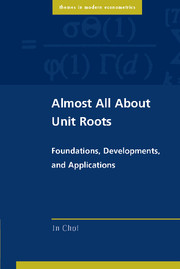Book contents
- Frontmatter
- Dedication
- Contents
- Foreword
- Preface
- Abbreviations and Notation
- 1 Introduction
- 2 Inference on Unit Roots: Basic Methods
- 3 Unit Root Tests under Various Model Specifications
- 4 Alternative Approaches to Inference on Unit Roots
- 5 Other Issues Related to Unit Roots
- 6 Seasonal Unit Roots
- 7 Panel Unit Roots
- Epilogue
- References
- Index
Foreword
Published online by Cambridge University Press: 05 May 2015
- Frontmatter
- Dedication
- Contents
- Foreword
- Preface
- Abbreviations and Notation
- 1 Introduction
- 2 Inference on Unit Roots: Basic Methods
- 3 Unit Root Tests under Various Model Specifications
- 4 Alternative Approaches to Inference on Unit Roots
- 5 Other Issues Related to Unit Roots
- 6 Seasonal Unit Roots
- 7 Panel Unit Roots
- Epilogue
- References
- Index
Summary
Socioeconomic trends figure prominently in media discussion and the financial pages of newspapers. They dominate data, guide policy decisions, and attract intense interest that extends well beyond the subject matter of economics and finance. In spite of this widespread influence trends are poorly understood. They are the inscrutable Hamlet of econometrics. No one really knows what they will do next.
During the 1980s econometrics embarked on a revolutionary journey that opened up a new understanding of the stochastic properties of trend. The unit root revolution changed the way the profession thought about trend by emphasizing the role of random elements in the trend mechanism and by formulating a technically well-defined concept of long-run behavior that did not remove randomness. By the 1990s, functional limit laws, stochastic integrals, and functionals of stochastic processes had overtaken econometrics in a firestorm that swept away earlier methods. New symbols of limit theory forever changed the pages of the mainline economics journals. New thinking penetrated econometric teaching and empirical practice. And a vast literature of applied economic analysis was born that demonstrated surprising sophistication in its use of modern econometric technology and nonstandard limit theory.
The implications of this unit root revolution have been enormous. The methodology exported itself throughout the social and business sciences with concomitant changes in thinking that acknowledged the ubiquitous presence of nonstationarity in data. The methods now reach into the natural sciences in areas as diverse as paleoclimatology and biodiversity with datasets that span hundreds of millions of years rather than the decades and centuries of economic data.
The single most important tool in the development of a theory for non stationary time series was the use of limit laws on function spaces, first brilliantly exposited by Patrick Billingsley in his monograph Convergence of Probability Measures, published in 1968. Measure theoretic principles in metric spaces underpinned all the foundations of this major work.
- Type
- Chapter
- Information
- Almost All about Unit RootsFoundations, Developments, and Applications, pp. xv - xviPublisher: Cambridge University PressPrint publication year: 2015

